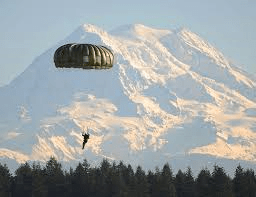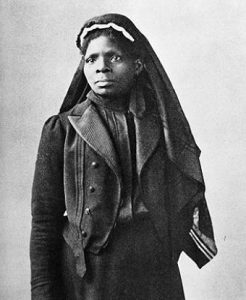Winner of theSpring 2018 StMU History Media Award for
Best Article in the Category of “Social History”
What is courage? What is strength? Perhaps it is being ready to fight for your nation even when your nation isn’t ready to fight for you.1 Imagine jumping out of a plane for the sole purpose of protecting that same nation. That is exactly what the 555th Infantry, the first all African-American unit, did during World War II. They stood in the doorway of the plane with a hundred pounds of gear strapped to their backs and await the jumpmaster’s commands.2 They hear “load” and “follow the trooper in front to your spot” and “wait.” As your turn approached, you looked down and saw the world below you as the wind ripped around your face. The men in the 555th battalion stood out among the rest of those troopers because they had to fight to be able to stand on the edge of that plane’s doorway and stare down fear in the face. They did this for the sake of a nation that segregated and mistreated them.

During World War II, paratroopers would leap from planes and parachute behind enemy lines to gather intelligence or fight from the inside of a battle and work their way out. Many, including the US military, believed that to be a paratrooper one needed specialized training, extreme physical fitness, courage, and, up until the Triple Nickles, white skin.3 The 555th Parachute Infantry Battalion was not legitimately formed until December 31, 1943. Before officially becoming a unit, many of the African-American soldiers did menial things like cooking and cleaning.4 Enlisted African Americans were segregated from white soldiers and regularly assigned to those kinds of duties. While thousands of American soldiers were fighting the Axis powers, African-American soldiers were fighting discrimination to be able to fight alongside those overseas. However, at Fort Benning, Georgia, one enlisted African American, Walter Morris, decided he wanted to change that. Morris and his company were assigned the task of cleaning up the training areas where the white paratroopers prepared for parachute duty. Morris saw the struggles and low morale of his company, so he decided to give them a goal to strive towards. Each night after all the other infantry parachute units finished training, Morris and his men would run through the same course that they saw performed earlier that day. This course included 34-foot towers, mock aircrafts, and pull-up bars.5 They secretly went behind the backs of authority figures just to feel a new sense of purpose. Not long after this, Morris saw his men transform into soldiers. However, that all came to a crashing halt when the company’s secret training sessions came to the attention of the commanding General Ridgely Gaither as he drove past the training field one night. The next day Morris was called to his office while the rest of the battalion awaited their fate.
Morris walked into the office and explained what he and his men had been up to and accepted full responsibility for their actions. However, in an unexpected turn of events, the general said, “I’m going to tell you something you don’t know, Walter Morris,” and proceeded to praise him and his men for taking initiative.6 The general officially assigned Morris as the first sergeant of the newly created 555th Parachute Infantry Unit as a test platoon. As Morris left, he said, “My head was in the clouds… My heart almost bust right there.”7
The 555th Infantry, also affectionately nicknamed the Triple Nickels, began training in January 1944. The men knew that they had a difficult challenge ahead of them, because they had to be better than any other unit to be considered equivalent. There were different stages of training that they had to undergo to be able to graduate. Stage A consisted of extreme physical fitness from daylight to dark, with classes on equipment and orders in between. In Stage B they began using equipment to complete obstacles on a much higher level. One of these training sessions included the Trainasium, which was a large obstacle course in the air that was used for agility exercises, and which would test a trainee’s ability to carry out simple instructions and activities above ground level as well as help the trainee conquer any fears of heights he might have.8 Therefore, the paratroopers worked and trained twice as hard as the white paratrooper units.9 Soon, the 555th became one of the best trained battalions in the army. When graduation arrived on February 8, 1944, seventeen paratroopers received their wings. Morris was the first African-American paratrooper to parachute out of a plane. They were the very first all African-American paratroop infantry, while also taking a step in the direction of ending segregation in the military. They were pushing the government towards racial justice and beating the odds of being an African-American paratrooper. Not long after they graduated, they became more well-known, and other African Americans began to enlist to be a part of the company. So many men joined up that the company grew into a battalion. The Triple Nickels patiently waited to be assigned to go join the fight in Europe, but the assignment they received was not what they had expected. The battalion was assigned to a 300-man smokejumper firefighting component in Camp Pendleton, Oregon.10

The Japanese had created a type of incendiary bomb that Americans commonly called balloon bombs. Japanese Lieutenant-General Reikichi Tada led a program that designed a four-meter balloon capable of delivering explosives up to seventy miles.11 After nearly a year of research and testing, his team came up with a design capable of remaining aloft for thirty hours at an altitude of 25,000 feet for over hundreds of miles.12 The Japanese would launch the balloons from submarines, which would release a 5-kilogram bomb once it touched down. The bombs were intended to land in forests and cause massive forest fires, which would put the lives of Americans at risk. The American navy would not send out aircraft or ships to stop these submarines because they did not see it as a large threat. The Japanese kept modifying and perfecting their balloons to the point that they could fly all the way from Japan to America. At one point, America had approximately ten thousand balloon landings. They needed someone to be able to get in and disarm them quietly. The Triple Nickles were disappointed in their new highly classified mission, but were pleased that they had been assigned a task to help America in the war.
These bombs were initially discovered by a young preacher, his wife, and five teenagers. They stopped because they had found a truck stuck in the mud. They all got out and were heading over to offer some help. However, his wife and the five children spotted a large balloon not far from where they were standing. Before the young pastor could tell them not to touch it, a large blast exploded from within the balloon. All six innocent Americans died in the explosion and the army and forest service then started discovering more of these balloon bombs. Shortly after, the army began Operation Firefly. Although the Triple Nickles did not get to go overseas, they began to see the importance of their mission and the contribution they would make, even if no one was watching.

This 555th Infantry Battalion was assigned to the Forest Fire Service as part of Operation Firefly.13 Operation Firefly was tasked to prevent forest fires, halt forest fires, or prevent an explosion if the balloon bombs were still armed. The Forest Service was having a hard time battling the fires because they could not get men into the forest fast enough to stop the fires while they were still small. The men took part in training to learn how to parachute down into rugged terrain and set up a fire line to stop the fires. The battalion also went through demolition training so that they could disable unexploded bombs. They were given fifty-foot ropes in case they got stuck in trees, and a parachute. The men started wearing old football helmets with chicken wire as face masks to protect them from branches and rough landings. The unit would stay in the fire zones and forests for days at a time, and when they extinguished a fire, they would then hike back to base miles away. The military and Forest Services kept the missions of the Firefly operation secret. They did not want Americans to know that America was under attack on its own soil, and they did not want the Japanese to know that their small-scale attacks were successful. The 555th Parachute Battalion became the first and only “smoke jumpers.”14
In the spring of 2010 the Pentagon paid tribute to the Triple Nickels for being the US Army’s first all-black paratrooper unit and for their contributions to the safety of America.15 By the end of the war, the 555th parachute infantry battalion logged more than 1,200 smoke-jumping missions. The 555th infantry smokejumpers’ assistance in Operation Firefly helped save American lives. But it also helped to keep the hopes of Americans positive during the war by keeping the balloon bombs a secret. They succeeded where they were not expected to succeed and overcame pitfalls that were put there. It had nothing to do with the color of their skin. It had to do with the bravery that each one of those men had inside of them.
- Tonya Lee Stone, Courage has no color: The story of the Triple Nickles: America’s first Black paratroopers (Somerville, Mass.: Candlewick Press, 2013), 3. ↵
- Tonya Lee Stone, Courage has no color: The story of the Triple Nickles: America’s first Black paratroopers (Somerville, Mass.: Candlewick Press, 2013), 5. ↵
- Tonya Lee Stone, Courage has no color: The story of the Triple Nickles: America’s first Black paratroopers (Somerville, Mass.: Candlewick Press, 2013), 9. ↵
- Jacqueline M. Hames, “Jumping into History: The Army’s First African American Paratroopers,” Soldiers 2, (2014): 1. ↵
- Robert F. Dorr, “555th Parachute Infantry confronted challenges, bigotry,” Army Times 61, no. 30: 41 (2001): 2. ↵
- Jacqueline M. Hames, “Jumping into History: The Army’s First African American Paratroopers,” Soldiers 2, (2014): 1. ↵
- Tonya Lee Stone, Courage has no color: The story of the Triple Nickles: America’s first Black paratroopers (Somerville, Mass.: Candlewick Press, 2013), 23. ↵
- Tonya Lee Stone, Courage has no color: The story of the Triple Nickles: America’s first Black paratroopers (Somerville, Mass.: Candlewick Press, 2013), 32. ↵
- Jacqueline M. Hames, “Jumping into History: The Army’s First African American Paratroopers,” Soldiers 2, (2014): 1. ↵
- Jacqueline M. Hames, “Jumping into History: The Army’s First African American Paratroopers,” Soldiers 2, (2014): 2. ↵
- Ross Allen Coen, Fu-go: The Curious History of Japan’s Balloon Bomb Attack on America (Lincoln, NB,: University of Nebraska Press, 2014), 17. ↵
- Ross Allen Coen, Fu-go: The Curious History of Japan’s Balloon Bomb Attack on America (Lincoln, NB,: University of Nebraska Press, 2014), 17. ↵
- Jacqueline M. Hames, “Jumping into History: The Army’s First African American Paratroopers,” Soldiers 2, (2014): 2. ↵
- Ross Allen Coen, Fu-go: The Curious History of Japan’s Balloon Bomb Attack on America (Lincoln, NB,: University of Nebraska Press, 2014), 32. ↵
- Brendan Manley, “‘Triple Nickle’ para jumpers honored,” Military History 10, (2010): 14. ↵



90 comments
Matthew Wyatt
This is a fun and fascinating portrayal of a group of truly brave American heroes. I had never heard of the “Triple Nickels” before, and I’m glad I had the opportunity to learn more about them. My one critique would be that the article switches tense randomly in several areas. This is a common problem with historical narratives, where its hard to decide if you want to depict the events as if they are happening right now or in their correct temporal context. My advice would be to read through and make a conscious decision about whether you want the tense of the article as a whole to be present or past. Besides that, this work is an interesting read that reminds us how some great men in our nation’s past had to serve valiantly despite knowing that they would be treated as second class citizens if they were lucky enough to return home.
Robert Rodriguez
These African American soldiers trained harder to become soldiers in the first place and did an intense job that not many people are capable of accomplishing. This is truly empowering to the African American community that these men broke barriers despite unequal rights and treatment. These men wanted to serve and fight for their country, it was truly inspiring to read that they persevered through many obstacles to do so in a different way. I could read it for a third time and I wouldn’t mind!
Regina De La Parra
I had never heard about this topic but I wish I did because it is really interesting. I am currently writing an article about World War I (I know this is about WWII), but it is really interesting how governments were and are currently looking for better ways to advance in the war and ways to be ahead of the enemy. I think this article really captivated that idea. Great job Hannah!
Tyler Sleeter
Great article with so much information. I have never heard of the 555th Infantry Battalion until reading this article. It has always been my opinion that jumping out of perfectly operating airplane is the definition of insanity, but I can understand and accept the purpose for it in a military setting. It is a shame that the soldiers in this unit had to work twice as hard to prove they were as qualified simply because they had darker skin then the soldiers in the other units. It is good that the Pentagon finally gave the unit the recognition they deserved, even it did take too long to happen.
Destiny Leonard
Great article!I had never hear about this topic before. The author provided detailed information and presented it in a way which showed the background history in a very interesting light. The 555th Infantry
is definitely a group of people in which we should hear more about in history. They were wiling to fight for their country and should be remembered for their acts of courage.
Timothy ODekirk
I have previously commented on this article before and remember it extensively well. It is interesting how during world War 2 African American soldiers had to be classified by a different section or category, such as paratrooper. Either way I found it interesting how paratroopers were the African American soldiers of World War 2. In my opinion, I feel like this is another form of segregation in the United States military history, on how African American soldiers can be both segregated and mistreated while trying to fight for the nation that they loved.
Natalia Flores
Operation Firefly sounds not only dangerous, but a job not for the faint of heart. Diving into a forest fire or a smoke filled forest sounds painful since there are branches and intense heat when parachuting into it. I didn’t know that the Japanese successfully carried out firebombs into the US during WWII and that it killed 7 people by complete accident. I’m glad they got the recognition they deserve since they served the country with honor and loved it past the racism and oppression it treated them with.
Fumei Pinger
I can’t believe I’ve never heard of the 555th Parachute Infantry Unit. I really liked the fact that this team was an accidental discovery by General Gaither, and how Morris thought he was going to be punished but rewarded instead! This is a great story about the determination and the drive to be the best. Although they didn’t get a chance to fight overseas they were still heroes on the home front.
Arianna Kennet
Interesting article, a topic I had not read about before. The author did a good job in providing detailed information in certain parts, and bringing out yet another story in history that should be known by people. The 555th Infantry seemed to be very courageous and strong people who really stood up for and fought for their country, something not many people can do. They are heroes who should be remembered.
Christopher Sanchez
This story reminds me of the Red Tails or Tuskegee Airmen how they were enduring racism but finally got to fight in Italy. There are a lot of stories of African American soldiers sacrificing their lives for their country who aren’t recognized for it. Segregation was a big issue that didn’t allow the same opportunities for African Americans. I believe that anyone who enlists no matter what color or race they are should protect their country.